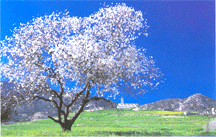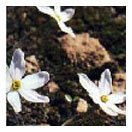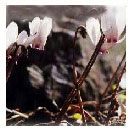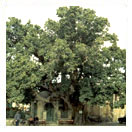Nature Of North Cyprus
Your blossoms,
Your green almonds
How graceful you are
Is it my own essence,
On that one occasion in the year when
You and I share this joy?

Nature wakes up in November when the fields adopt a coat of green as the whole of the island becomes covered with fresh growth, following the advent of the first rains. Anemones, cyclamens, narcissi, hyacinths, irises, wild orchids, wild tulips and almonds all bloom until the end of March. There is no other country in the Meditterranean which can boast over thirty species of wild orchids
It is a well-known fact that North Cyprus is a wonderful place in every season. Every season is different on our island. You don't wake up to the day, so much as wake up into a dream world. The dream world that is made up of the colours of rainbow.
Wild Flowers
As Cyprus enjoys the Mediterranean climate the natural flora of the Island is rich and interesting to the botanist, as well as to the uninitiated.
The Summer visitors to the Island will be struck by the apparent barrenness of the plains and foothills which are frequently bare of trees for miles. This seeming infertility derives from the fact that the greater part of the lowland flora consist of winter annuals.
The Island, being in the Eastern part of the Mediterranean, does not get enough rainfall in Summer. But the animals to be found in the island have a wide-spread origin. Some can also be found in North West Europe, while others can be found in South Africa.
Tulipa Cypria (Cyprus or Black Tulip)
The cup or the solitary head, has 6 oval petals with pointed tips, the black basal blotch on each petal being only slightly bordered by yellow; stamens thick and sturdy, with bright yellow polen borne on dark red oblong anthers; stigmas creamy, conspicuous on top of the ovary. Stalk 30 cm high,pale yellow-green. Leaves at bases spreading sideways, about 20 cm long, grey-green with undulating margins; those part-way up the stem smaller, narrower and sharply-pointed.
Ranunculus Asiaticus (Turban Buttercup, Persian Crowfoot)
Stamens numerous, blackish violet, mahogany brown, or light tan. Fruiting heads, cylindirical. Leaves variable; root leaves either undivided or cut into wedge-shape segments; stem leaves more narrowly dissected. These beautiful flowers have many different colours, which makes spotting them exciting. For the complete novice, identifying them can can be confusing, because at first sight they are not unlike Crown Anemones -the quickest way to differentiate between them is to be sure that there are green sepals below the petals; there is no green bract wrapped around the stem under the flower.
Anemone Coronaria (Crown Anemone)
Flowers large, 4-8 cms across, without green sepals, which distingguishes it clearly from the Asiatic Buttercup; 5-8 oval petals, in many different flower colours of lavender, lilac, deep purple, red to scarlet, rose-pink, magneta, and more rarely white, blue or in many and various intermediate shades, sometimes two-coloured, with a white or pale base; even the white have a circle of white in the area near the stamens (the white petals make this circle more difficult to see, but caught in the sun at certain angle the white circle shines silvery-white or white).
The red form and the shades of purple are the most widespread, but it is very exciting to find the rarer pale apricot pink and the deep salmon pink. Fruiting heads become taller and more cylindirical as the petals fade. Stamens numerous; filaments pink, violet or red; anthers purplish or black; styles threadlike 1-2 mm long, blackish. Torus ovoid; nutlets densely woolly. Leaves broadly triangular, 3-12 cm across, divided into 3 triangular, stalked, pinnatifid or deeply divided segments, ultimate divisions narrow, variously toothed; stalks 3-7 cm long.
Narcissus Serotinus (Late Narcissus)
Capsule 1 cm long. Leaves only 1-2, very slender, usually appearing after flowering.
Crocus Veneris [var. Cyprium] (Cyprus or Autumn Crocus)
Leaves 3-4, equalling the flower in height, but occasionally with only the tips showing; up to 1 mm wide, bright dark green, with a narrow silvery median stripe on the upper surface.
Cyclamen Cyprium (Cyprus or Autumn Cyclamen)
Leaves spade-shaped, fleshy grey-green, marbled; leaf underside rich purple or crimson. Tubers with rough greyish bark, about 7 cm diameter or less; roots appear from one side of lower surface.
Helianthemum Obtusifolium (Yellow Cyprus Sun Rose)
Straggling shrublet with branches to 25 cm long, growing on stony ground; flower-buds hairy, purple-black striped with two outer sepals and 3 inner broader ones like pointed spades; 5 pale yellow petals 15 mm long; stamens 4 mm long with distinct oblong anthers which show clearly in the open-plan arrangements of the stamens.
Centaurea Aegiliphila

Limonium sp. , Mathiola sp., Pancratium maritimum Sand-Lily", Urginea maritima with huge leaves in spring and long spikes in summer, Lycium ferocissimum, introduced from sout-africa with orange round berries, Helianthemum obtusifolium an endemic rockrose, one or two stemless Centaurea sp. , a small blue annual linum and at least three halophytic shrubs with more or less succulent leaves.
The Oldest Living Thing In Cyprus - The Cathedral Sycamore Fig Tree in Famagusta
It is a variety of tropical fig tree, with the botanical name of `Ficus Sycomorus', a native of East Africa. The main trunk of the tree is surrounded by smaller trunks which have grown into the main trunk, and give it added support. It appears that they have sprung up from the massive root system.
An old Turkish-Cypriot who has lived all his life near to the cathedral exclaimed to the writer, `There are seven of these trunks round the main trunk, one for every hundred years'. Obviously, this is just simple folk lore but there are scientific background to this.
Don't be surprised if some time in February the leaves all disappear, giving the illusion that the tree has died. Yet in a month all the leaves are back, covering the whole tree with dense green foliage. The tree is what botanists call, `minimal deciduous'. The tree is listed under the Department of Culture's National Heritage List and is looked after by the Department of Forestry Famagusta Office.
Content provided by theorchidwalk.com



